 Image search results - "food" Image search results - "food" |

Preparing unagi eel, Narita, Chiba. Also see the video at YouTube.Slicing it in half lengthwise.
|
|

Striping off the boney spine.
|
|
|

Geisha chocolate ゲイシャ チョコSome years ago, when a Finnish friend visited Japan and gave me this Geisha chocolate from Finland, I was very amused. Why in the world did they name it "geisha??" It's milk chocolate with a soft hazelnut filling.
Then when I went to Finland, I was surprised to see this chocolate brand almost everywhere. It's made by a company called Fazer, and when you look at their Web site, they explain in Finnish why they named it "geisha." (Wish I could read it.) The logo on the packaging uses a nice drawing of a geisha. But at the company's Web site, they have a wallpaper gallery showing a real human modeling as an obviously fake geisha.
No offense to the company, the model, makeup artist, and chocolate, but she is one of the worse-looking geisha models I've ever seen. Egad!! She might even be a man.
Take a look: http://www.fazermakeiset.fi/ Click on the Geisha button, then click on the fourth candy from the top to see the wallpaper.
After careful analysis, I know why Fazer's geisha looks so awful: Her fake wig is way too high above her ears. It's too small or too short for her (or his) head. The wig was probably for a young girl. See this photo and compare. They should stick to the cartoon logo instead.
この「Geisha」チョコはフィンランドに大人気。何故そう名付けたか分かりませんが(フィンランド語の説明がある)、数年前に初めてフィンランドの友人からもらったとき爆笑だった。そしてフィンランドへ初めて行ってこのGeishaチョコがどこでもあって驚きました。
Fazerという会社が作っていてHPを見るとなんと人間の「ゲイシャ」のモデルさんも登場している。このゲイシャのモデルもとても見苦しい。よく見ると、その桂が小さ過ぎて(または高すぎる)耳が丸見えてとても変な感じ。
HP: http://www.fazermakeiset.fi/
Geishaのボタンをクリックして、上から4番目のキャンデイをクリックするとそのモデルの壁紙がでる。いかがでしょうか。
|
|

Mini octopus
|
|

Home-cooked mealI forgot the name of this pea soup, but it was good.
|
|

Seafood restaurants
|
|

Piirakka tarts
|
|

Anko seafood soup (miso-based)
|
|

Fresh oysters
|
|

Baby scallops
|
|

Ika squid
|
|

Dried fish
|
|

Train back to Mito.
|
|
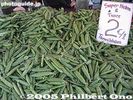
BeansSomething like beans in a pod. Sweet. At Market Square.
|
|

It is really good! Different flavors are offered during different days of the tournament. Top is shoyu (soy sauce) flavor, and bottom is salt flavor. Miso flavor is also offered.
|
|
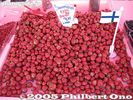
BerriesAt Market Square.
|
|
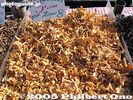
Dried mushroomsAt Market Square.
|
|
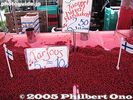
BerriesAt Market Square.
|
|
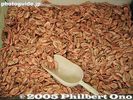
ShrimpIn supermarket.
|
|

Natto fermented beans
|
|

TomatoesIn supermarket. The leaves at the top of the tomato are removed. They look bald. Something we don't see in Japan.
|
|

Picnic food (at Suomenlinna)
|
|

My lunch. Ball-shaped gyoza. The skin is slightly crunchy.
|
|
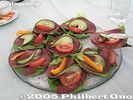
Reindeer toppingMy first dish at Kuusamo. Delicious.
|
|
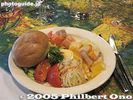
SaladAt Kuusamo Sokos Hotel restaurant.
|
|

Main dishAt Kuusamo Sokos Hotel restaurant.
|
|
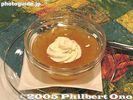
Dessert: Cloudberry puddingCloudberry is a delicacy from Lapland. I bought some cloudberry jam at Helsinki Airport. Someone should import it to Japan.
|
|
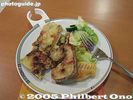
TartAt Kuusamo Hall.
|
|
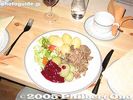
Reindeer meat + potatoesThe delicious dinner we had when we went to the Finnish sauna and saw the aurora.
|
|
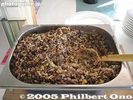
Fried rice or pilafIn Kuhmo.
My question is, is there a Finnish restaurant in Tokyo?
|
|
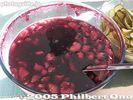
Dessert
|
|
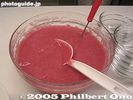
Pudding dessert
|
|
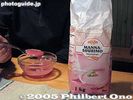
Pudding dessert
|
|

Yokosuka curry
|
|
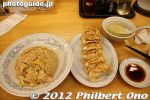
Cha-han fried rice and gyoza
|
|
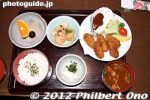
Fried oysters in Hiroshima.
|
|
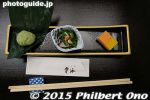
Appetizer, Kyoto
|
|
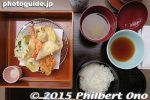
Tempura
|
|

Kaki-fry teishoku or fried oysters
|
|

Shabu-shabu dinner with the shabu-shabu pot having a divider so we can try two different flavored broths.
|
|

Sukiyaki dinner
|
|
|
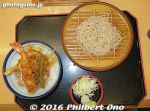
Small tempura donburi and cold soba noodles at Tenya
|
|
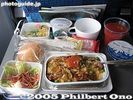
Finnair: Tokyo to HelsinkiThe food wasn't so bad.
|
|
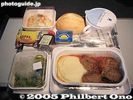
Finnair: Helsinki to TokyoMeatballs and mashed potato.
|
|
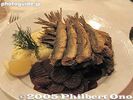
Baltic herring バルト海のニシンA specialty of Helsinki. This was served at Sea Horse, a well-known restaurant. This one serving must have had about 20 of these herrings stacked up. I ate maybe 10 of these fish. They were excellent, but I could eat no more. Took the rest home in a doggy bag. It took another 3 days to eat the rest.
一人分になんと20匹も積み重なっていた。多すぎて残った分を持ち帰った。
|
|
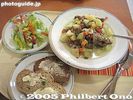
Lunch (reindeer meat) 肉はトナカイKuusamo Hall also has a restaurant serving good food.
ホール内はレストランもある。
|
|

Venetian food ヴェネツィアの料理
|
|
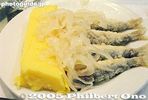
Venetian food ヴェネツィアの料理
|
|

Grilled veggies
|
|
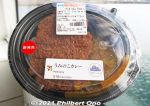
My lunch on the boat was Uminoko Curry, the same dish served on the Uminoko Floating School.
|
|
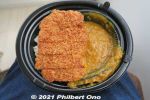
Uminoko Curry had pork cutlet and kind of sweet, mild curry. Sold only by 7-11 in Shiga for a limited time of three weeks from late Jan. 2021. Best place to eat it was on Lake Biwa.
|
|

Inside the ceramic flask they bake sweet potatos.
|
|

The 1st Shiga B-grade (B-kyu) Gourmet Battle was held in Otsu on July 30-31, 2011 on the Hama-Otsu lakefront. B-class (B-kyu in Japanese) gourmet is food that is cheap and aimed for the working class. It could also be good 'ol home cooking. *Note that this event is no longer held annually.
|
|
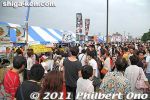
B-grade food festivals have proven to be popular in various parts of Japan and Shiga finally started its own. With an estimated 120,000 attendees over the two-day period, Shiga's first B-class food fest was wildly popular as you can see by this crowd
|
|
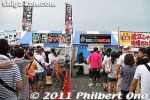
Long lines were the norm at most food booths lined along the lakefront.
|
|

There was hardly any crowd control nor crowd direction. We just had to work our way through the lines when moving to another booth. Some lines extended all the way to the hotel behind the park.
|
|
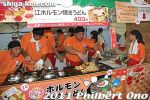
All the B-grade food served had some homegrown ingredient from Shiga. Whether it was Omi-gyu beef, red devil's tongue, Omi-mai rice, or Biwako fish. This is yaki-udon noodles.
|
|
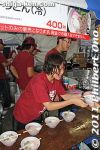
They employed a ticket system, so we had to buy a book of tickets. Each ticket was worth 100 yen and the food was priced from 100 to 500 yen.
|
|
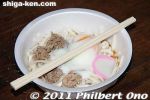
Cold noodles with Omi beef.
|
|
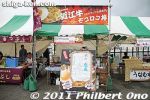
I went on the second day in mid-afternoon and already many booths had sold out. This is a "Sold out" (kanbai 完売) sign.
|
|
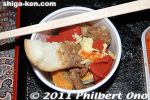
However, I did manage to buy some food at a few booths, and all were very good. Tasty like I've never tasted before. Unique and original dishes I would say. This is red devil's tongue with gravied bread.
|
|
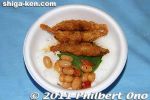
Fried fish and sweet beans over rice. Interesting combination.
|
|
|
|
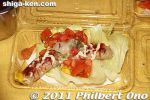
Omi Italian sausage. Hot dog like I've never tasted before. Very good.
|
|
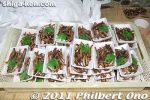
Fish from Okishima island. 200 yen per pack.
|
|

Matcha shaved ice for dessert. I ended up buying two 1000-yen ticket books. Cheap food, but you want to try as much as possible and end up spending around 2,000 yen.
|
|
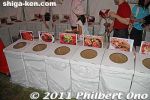
It was a gourmet battle, so we could vote for our favorite B-class food by throwing away the wooden chopsticks in the these trash bins for each food booth. They weighed these bags of chopsticks and the heaviest won the battle.
|
|
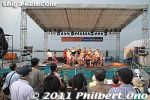
The B-grade gourmet battle was part of the Hama-Otsu Summer Festa which included a free jazz concert. I'm sure they will hold this B-class Gourmet food festival every year. Don't miss it, and go early.
|
|
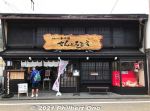
Gujo-Hachiman is also famous for food replicas which were invented by Gujo-Hachiman native Iwasaki Takizo (1895–1965). This shop called Sample Kobo displays a large sample of them. Also for sale. サンプル工房
|
|
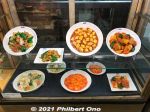
Sample Kobo factory for food replicas which were invented in Gujo-Hachiman. Looks delicious. サンプル工房
|
|
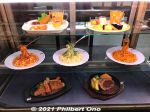
Gujo-Hachiman native Iwasaki Takizo (1895–1965) invented the ubiquitous food replicas we see today in restaurants in Japan.
|
|
|
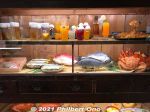
Gujo-Hachiman today makes over 50% of Japan's food replicas. Iwasaki made his first food replica, an omelette, in 1932.
|
|
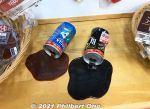
They also offer short lessons to make your own food replicas like spilled coffee.
|
|
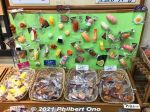
Fake sushi on key chains.
|
|
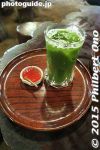
Ordered matcha tea
|
|
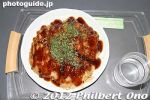
Hiroshima is also famous for okonomiyaki.
|
|
|
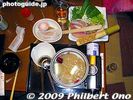
Nabe (stew) with vegetables and some pork. Cook it yourself.
|
|

Chanko nabe, a meat and vegetable stew eaten by sumo wrestlers. Served at the Ryogoku Kokugikan during sumo tournaments.
|
|
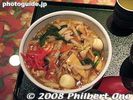
Chuka-don or a bowl of rice with vegetable topping. 中華丼
|
|
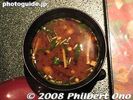
Dark miso soup with small mushrooms. (Came with the chuka-don.)
|
|

Udon with raw egg
|
|

Looks like fried chicken with goya (bitter melon) and udon noodles.
|
|

Kaki-fry teishoku or fried oysters in a complete meal.
|
|

Steamed rice with small clams.
|
|
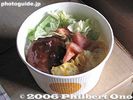
Japanese-style Locomoco, originally from HawaiiFrom a well-known bento shop. Not very good.
|
|

Making okonomiyaki
|
|

Making okonomiyaki
|
|

Okonomiyaki is like a pancake with vegetables and meat.
|
|

Okonomiyaki with sauce and ready to eat. Osaka.
|
|

Funa-zushi or fermented carp fish from Lake Biwa. 鮒ずしDelicacy of Shiga Prefecture.
|
|

Omi beef
|
|

Sashimi donburi
|
|

Tempura mushroom
|
|

Rice with shellfish
|
|
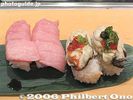
Toro and oyster (kaki) Sushi
|
|

Okonomiyaki (Osaka)
|
|

Tempura teishoku at Tenya
|
|
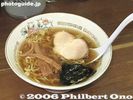
Ramen
|
|
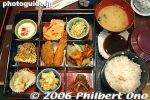
Chinese dinner
|
|

Making okonomiyaki
|
|

Puffer/balloon fish totally unaware of their ultimate fate.
|
|

Sake rice wine
|
|

Tempura and more
|
|

High-class meal
|
|
|
|

Kamaboko fish cakes from Himi, Toyama
|
|

Funa-zushi, Shiga Prefecture. Fermented carp.
|
|
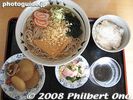
Soba noodles with daikon and rice. A perfect winter meal.
|
|
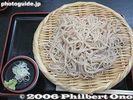
Cold soba noodles
|
|

Sashimi
|
|
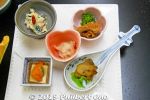
Appetizers.
|
|
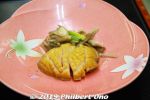
Abalone steak.
|
|
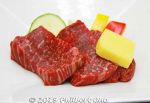
Local Hitachi Wagyu beef. ("Hitachi" is an old name for Ibaraki Prefecture. The famous electronics company Hitachi is also from Ibaraki.) 常陸牛
|
|
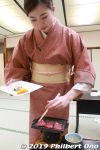
Hotel staff in kimono cooking my Hitachi Wagyu beef. 常陸牛
|
|
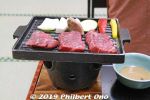
Hitachi Wagyu beef was just a small part of our dinner. We got really stuffed. 常陸牛
|
|
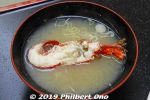
Lobster in miso soup.
|
|
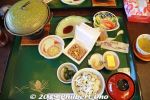
Breakfast included natto fermented soybeans. Ibaraki is famous for natto.
|
|
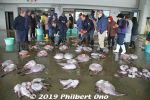
Hirakata Port's main catch is the monkfish/goosefish (あんこう), a type of anglerfish. Ibaraki Prefecture's coast is one of Japan's prime areas for monkfish. These are all monkfish being auctioned in the afternoon. 平潟港 せり見�
|
|
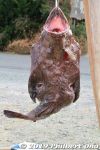
It's Kita-Ibaraki's famous fish and delicacy, monkfish, in the flesh. This one is 5 or 6 years old, weighing 12.7 kg. Only the female monkfish is eaten. The males are too small.あんこう
|
|
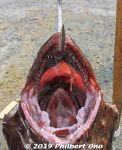
Look into the big mouth and see another set of teeth on the throat. All the teeth are pointed inward so its pray cannot escape. Like the aliens in the movie "Alien."
|
|
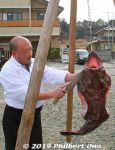
Monkfish being skinned and carved up by an expert chef. Since the monkfish is too slimy and slippery on a cutting board, it is hung like this for carving. It's a lot easier to cut up this way.He first takes off the skin (loaded with collagen).
|
|
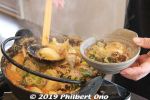
This is monkfish hot pot (dobojiru ankou-nabe) どぶ汁 with monkfish parts in a miso broth. I didn't have any problem eating it. The flavor was certainly not objectionable, it's just another kind of fish.It was already prepared for us and it wasn't the fish we saw carved.
|
|
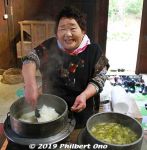
At Arigatee, we were charmed by the delightful Sumi-chan, a retired local farmer. She helped cook our lunch. Rice locally grown in Kita-Ibaraki. Thank you Sumi-chan for smiling!
|
|
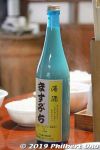
Local sake, a type called Doboroku (どぶろく) or nigori-zake (濁り酒). It's thick and cloudy-white. Sour taste. Made by a local brewer and restaurant named Masubuchi (増渕魚園).
|
|
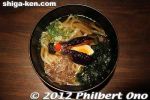
Hotaru (firefly) udon served by the Kashiwa restaurant inside Kashiwabara-juku History Museum in Maibara, Shiga. Firefly made of eggplant with the light from an egg slice.
|
|
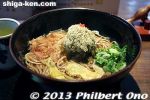
Yaito udon served by the Kashiwa restaurant inside Kashiwabara-juku History Museum in Maibara, Shiga. Yaito is moxa. The red dot (red ginger) is the burning flame.
|
|

Across from Ineura Park is the new Ine Tourist Information Center on the 1st floor and a restaurant (Funaya Shokudo 舟屋食堂) on the second floor where we had lunch.
|
|
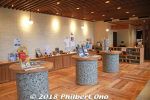
Ine Tourist Information Center on the 1st floor.
|
|
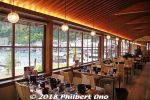
Funaya Shokudo restaurant. http://www.ine-kankou.jp/taste/funayashokudo/
|
|
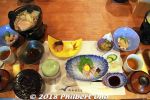
We had the Funaya Teishoku for lunch mostly seafood, worth ¥2,000.
|
|

Funaya Shokudo restaurant menu.
|
|

About Ine and funaya.
|
|
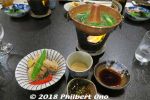
Shorenkan Yoshinoya ryokan is probably more famous for its food, especially crab during crab season (Nov. to March). But it wasn't crab season when we were there so we didn't have any crab. But the food was still excellent. Kyotango, Kyoto Prefecture.
|
|
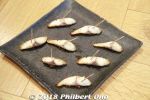
A local fish delicacy called "heshiko." Heshiko is made in this coastal region of Kyoto and Fukui Prefectures. It uses mackerel (saba), sardines (iwashi), or Pacific saury (sanma) that are salted and then fermented in rice bran (nuka). For heshiko, mackerel is most popular and the process takes two years. It is a traditional way to preserve fish for later consumption without refrigeration. It was a common (and cheap) food for the masses, but now it's a delicacy.
This restaurant believes too much salt is not so healthy, so they take only two weeks to salt and ferment the fish. This method is called asazuke (浅漬け) which means "lightly pickled." We sampled the mackerel prepared this way (and grilled), but I thought it was very salty already and hardly any taste of fermentation.
|
|
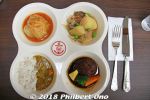
We had a special sample of the curry rice, cabbage roll, stewed hamburger, and potatoes and meat (niku-jaga). Curry rice is famous as a navy dish in Japan.Shoeikan restaurant, Maizuru, Kyoto Prefecture.
|
|

Yakitori restaurant in one of the narrow alleys in front of Kichijoji Station.
|
|

Yakitori
|
|

Yakitori
|
|
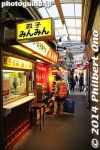
Gyoza shop in Kichijoji
|
|
|
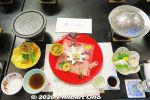
The start of our aesthetic and delicious kaiseki dinner at Kinugawa Park Hotels in Kinugawa Onsen, Nikko. 鬼怒川パークホテルズ
|
|
|

Eggplant
|
|
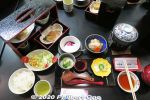
Breakfast at Kinugawa Park Hotels in Kinugawa Onsen, Tochigi.
|
|
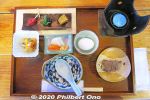
My lunch at Okariba restaurant. At Edo Wonderland in Nikko, Tochigi.
|
|

They serve black bass, Biwa salmon, catfish, and more.
|
|

Appetizers of our full-course, Chinese-style religious vegetarian cuisine at Icho-an. This plate was for four people. Very different, very colorful, and such a unique taste and deliciousness that I've never had before.Fucha ryori is healthy too. Well worth the ¥5,000 which I first thought was quite pricey for a religious meal with no meat. Got stuffed and we could take home some food too.
|
|

Fucha ryori became very popular after it was first introduced in Japan. No wonder. It looks exotic and tastes absolutely delicious. Salad.
|
|

Fucha ryori has no fish nor meat.
|
|
|
|

Rice was finally served at the end with pickles.
|
|

Dessert. One of the best meals I ever had in Japan. Advance reservations are required. It's not a walk-in restaurant. More info photos in Japanese: https://www.obakusan.or.jp/eat/
|
|

A simple bento (box lunch) fucha ryori at Manpukuji temple, Uji, Kyoto 普茶料理
|
|
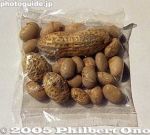
Bag of beans. I caught this from Dejima. They throw little bags of beans instead of individual beans. Bean bags are much easier to catch and to clean up afterward.
|
|

Obama confections such as manju, this time with the face imprinted (instead of the back of the head). Passed out for free.
|
|

Obama burgers were passed out free to the people attending the event. Free soft drinks (hot) also helped in warming my hands.
|
|

Obama rolled maki-sushi on sale.
|
|

Obama soba noodles, 500 yen per bag.
|
|

Dried bread in cans.
|
|

Saba-zushi or rice topped with mackerel, a local specialty in Obama, Fukui.
|
|

Soba noodles from the soba shop on the platform at JR Ome Station, Tokyo.
|
|
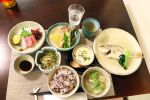
Dinner at Takemori Inn. Chawan-mushi, local fish, Yaeyama soba. The ryokan owner was very friendly. Not English-speaking though.茶碗蒸し、海藻と野菜和え、近海魚の刺身、近海魚の塩煮、煮物(冬瓜)、ソーキ、昆布、こんにゃく、黒紫米入り西表産ひとめぼれごはん、八重山そば
|
|
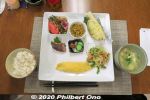
Delicious Okinawan breakfast at Takemori Inn/Ryokan (竹盛旅館).
|
|
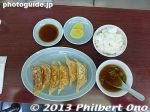
Gyoza with rice
|
|
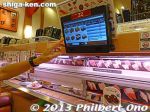
Sushi restaurant
|
|
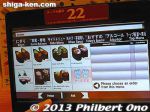
Touch panel ordering for sushi
|
|
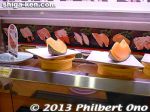
Kaiten Sushi
|
|
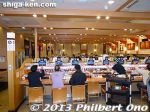
Large Kaiten Sushi restaurant
|
|
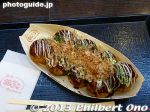
Takoyaki with pieces of octopus inside.
|
|
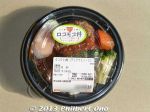
Loco moco bento.
|
|
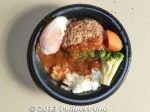
Loco mock with hamburger, gravy, and egg. For only 270 yen at a local supermarket. Not good though.
|
|

Gyudon beef bowl
|
|

Masu trout sushi at Mimasu in Samegai Trout Farm, Shiga Prefecture.
|
|

Dinner at a restaurant near Yudanaka Station. Yasai teishoku or fried vegetables.
|
|
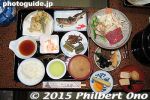
Dinner at Hisamatsu, Shirakawa-go. Includes Hida beef.
|
|
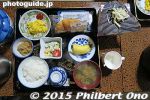
Breakfast at Hisamatsu, Shirakawa-go
|
|

Dinner at Isaburo: River fish and mountain vegetables. After dinner, the proprietress and her husband and daughter sang and danced for us. They demonstrated different traditional musical instruments and had us try playing them. It was great. However, I was told that they don't do that anymore.
|
|
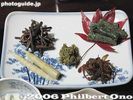
Mountain vegetables 山菜
|
|
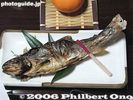
Grilled Iwana river fish
|
|
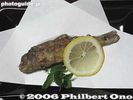
Fried Iwana, eat the head and all.
|
|
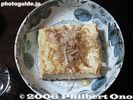
Tofu
|
|
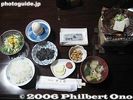
Breakfast at Isaburo minshuku
|
|
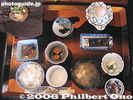
Breakfast at Otaya
|
|

Dinner
|
|

G8 Hokkaido Toyako Summit merchandise: Manju
|
|

G8 Hokkaido Toyako Summit merchandise: Confections sold at the train station kiosk
|
|

G8 Hokkaido Toyako Summit confection
|
|

G8 Hokkaido Toyako Summit potato confection.
|
|

Izushi soba is famous for having cold soba served on five small plates. Dip the noodles in the broth while adding different garnishes like grated yam, onions, and raw egg. 出石そば
|
|

Lots of soba restaurants in Izushi. This lunch cost ¥870. You can also order more plates of noodles. The history of Izushi soba goes way back to the early 18th century when the local lord brought it from Nagano (Shinano soba). 出石そば
|
|
|
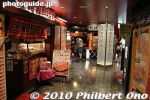
Gyoza restaurants in Utsunomiya Station. The city's gyoza connection started in 1940 when soldiers in the Imperial Japanese Army's 14th Division assigned to a garrison in Manchuria returned to Utsunomiya and brought back gyoza recipes.
|
|
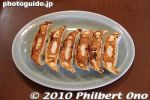
Soldiers in the 14th Division came from Utsunomiya. Sadly in 1944, the division was assigned to Palau and Anguar in the South Pacific where most of them died in bloody battles. What would a trip to Utsunomiya be without eating gyoza?
|
|
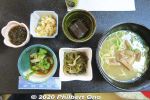
Ishigaki cuisine for lunch. Main dish was soba noodles. Side dishes of pig's ear, goya & tuna, juushi flavored rice (じゅーしー), local seaweed, and brown sugar jelly (dessert). Pig's ear is chewy/crunchy, not really tasty, but has a lot of collagen, so it's a health food.
|
|
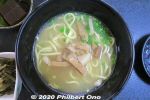
Yaeyama soba noodles
|
|
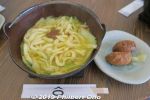
Lunch was Hoto noodles, famous in Yamanashi Prefecture. Thick, flat udon-type noodles in delicious miso-based broth, mixed with cut vegetables. Also came with Inari-zushi. http://www.houtou-fudou.jp/english.html
|
|

Biwako Shokudo restaurant serves its specialty: Tall pile of vegetables in a boiling pot. びわこ食堂
|
|

After cooking, the tall pile of vegetables (mainly Chinese cabbage) shrinks. This is for two people. Chicken and miso broth.
|
|

After you eat the main dish, mixing udon noodles in the miso broth is also good (if you still have room in your stomach).
|
|

Food stalls serving Hawaiian-like food.
|
|

Even shave ice.
|
|
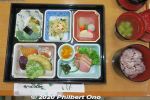
Lunch was named, "Okinawa Makunouchi Bento Akabana" (沖縄幕の内弁当「アカバナ」. ("Akabana" means "hibiscus" in Okinawan.) Price was ¥1,320.Iriomote black rice, champuru, brown sugar yokan: 西表産黒紫米入りごはん、アーサのお吸い物、うみぶどう、ミミガー、漬物、沖縄黒糖煮、 アンダー味噌、野菜天ぷら、ウムクジ(紅イモを米粉であえて揚げたもの)、かまぼこ、チャンプ ルー、黒糖羊羹
|
|
|
|
|